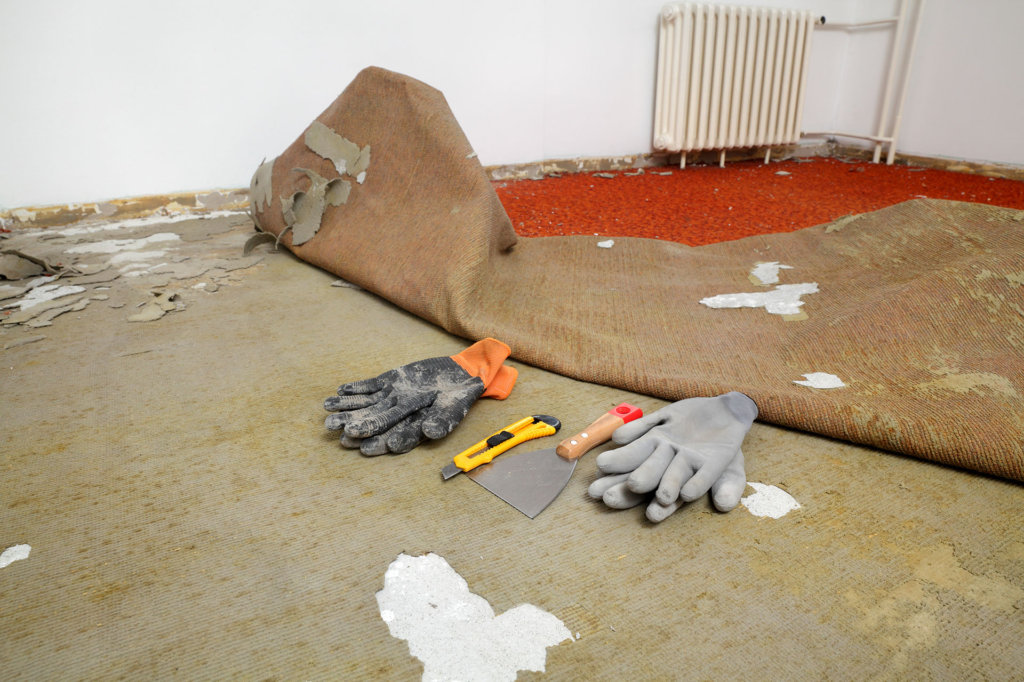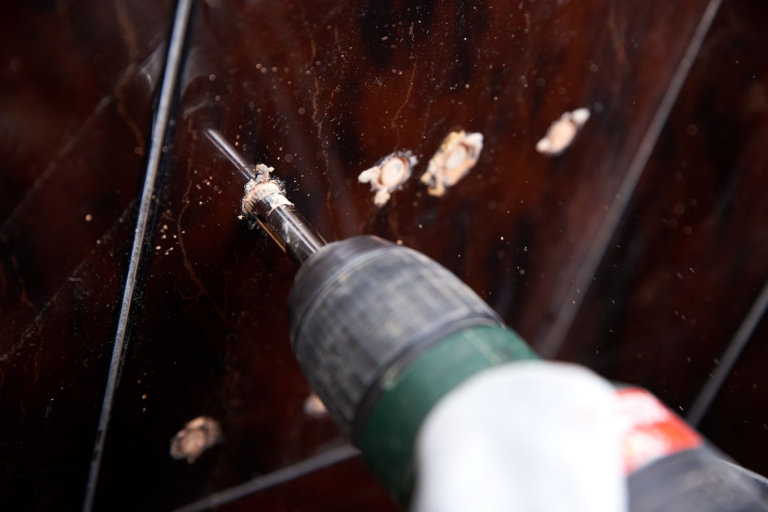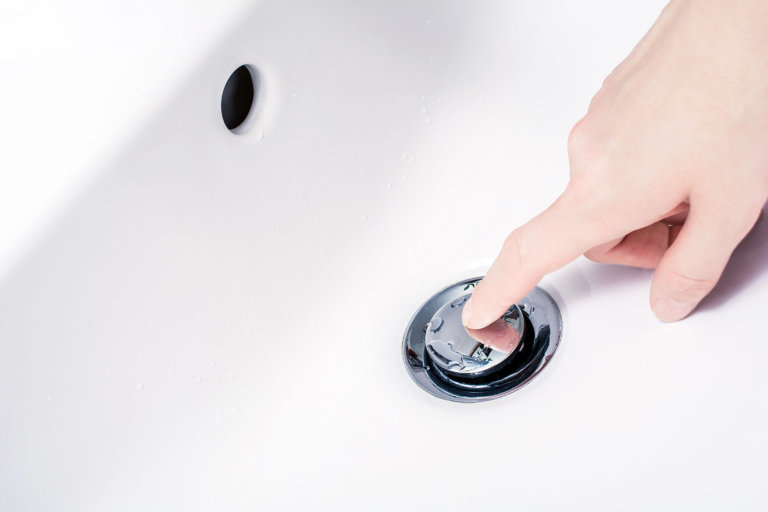Removing a carpet is more of a challenge than most homeowners imagine. Without following the right steps, you may create unnecessary work for yourself and may even damage the flooring underneath.
Professionally installed carpets are tacked down to the floor. After you manage to rip the carpet from the tack strips, you need to deal with big, bulky strips of old carpeting. You may also find that the padding was glued to the subfloor, creating more challenges for this project.
Taking the time to gather the necessary supplies and arranging disposal for the old carpet can save time and energy. Before you start to remove your carpet, make sure to review all the steps in this guide.
If you do not want to leave your floor bare, you may also want to plan your new flooring before tearing out a carpet. Decide if you want to add new carpet, lay laminate flooring, or refinish the hardwood.
Step 1: Get Your Supplies
Gather the following tools and supplies to make the project easier and safer:
- Work gloves
- Safety goggles
- Dust mask
- Utility knife
- Pliers
- Crowbar
- Floor scraper
- Bucket for collecting debris and tack strips
- Plastic trash bags for discarding the padding
- Broom, dustpan, and mop
- Shop vacuum (optional)
Carpets contain harmful dust and allergens that can increase the risk of symptoms related to asthma and allergies. As you tear the carpet, you are likely to release potentially unhealthy debris, making safety goggles and a dust mask essential.
Step 2: Arrange Disposal
After you remove the old carpet, you need to dispose of it. Unfortunately, the big rolls of worn carpeting will not fit in your residential trash bin, even when removing carpet from a small room.
Decide how you want to dispose of the carpeting before you start tearing it out:
- Hire a junk collector
- Rent a dumpster
- Check with your local trash service
Most cities have independent junk collectors that will gladly pick up your trash and take it to the dump for you. This is often one of the most affordable ways to get rid of large items.
If the carpet removal is part of a larger project, such as remodeling one or more rooms in your house, you may end up with additional trash. Renting a dumpster may give you enough space to toss out the old carpet and other rubbish.
Depending on where you live, your local trash service may collect old carpeting. However, you typically need to arrange the pickup separately from your regular trash pickup. You may also need to pay a small fee per roll of carpet. In some areas, you receive a sticker that you place on the item before setting it near the curb.
Step 3: Clear the Room
Completely clear the room before you start. Remove everything from the room, including wall décor.
Carpet is surprisingly bulky when you start to pull it from the floor. You will find it a lot easier to roll strips of carpet without any furniture or household items in the way.
If the room has baseboards or shoe molding that overlap the edges of the carpet, remove them as well. Baseboards are typically removed using a crowbar, hammer, and a flat tool, such as a paint scraper or flathead screwdriver.
Use the scraper or screwdriver to carefully loosen one end of the board. Use the tool to continue loosening the board along its entire length. After loosening the board, use a crowbar or hammer to slowly pry it from the wall.
Step 4: Remove the Carpet
With the room clear, you can start pulling out the old carpet. If you want to keep the carpet in one area, you need to score the boundary with your utility knife. For example, if the carpet covers two rooms and you only want to keep the carpet in one room, cut a straight line where you want the carpet to end.
Use a pair of pliers to grasp a chunk of carpet fibers near one of the corners. If the carpet does not lift from the tack strips easily, use your utility knife to a square from the corner. Make the cutout big enough for your hand.
As you pull the carpet up, some of the tack strips may come loose from the subfloor. Keep a bucket nearby for discarding loose strips and nails as you work.
After you get an entire side of the carpet up, fold it back about two feet. Use the utility knife to cut through the back of the carpet, separating the side that you pulled up into two to four feet sections. This allows you to roll the carpet into separate strips instead of one large roll.
Fold the carpet back over and grasp the first section while placing one foot on the next section. The carpet should tear easily, following the cuts that you made. However, you may need to occasionally use the utility knife.
Slowly work your way backward to the opposite side of the room, rolling the carpet as you go. After rolling the first section, repeat with the next one. Continue this process until you have rolled up the carpet into two-foot to four-foot-long rolls.
Step 5: Remove the Padding
If the padding is heavily deteriorated, it may come loose as you lift the carpet. You may also find chunks of padding stuck to the tack strips. Some areas may be stapled or glued to the ground. Use pliers to remove the staples and a floor scraper to scrape off the glued areas. Throw the padding away in plastic bags as you work.
At this point, you should notice piles of dirt and debris throughout the room. Use a broom or shop vacuum to sweep up the loose debris. Cleaning as you go is always a good safety practice to follow for any DIY home project.
Step 6: Remove Tack Strips
If you are installing a new carpet, you may save money by leaving the tack strips. Use a crowbar to pry the tack strips loose if you are installing different flooring or refinishing the subfloor.
Use the floor scraper to help lift stubborn strips that you can’t fit the crowbar under. A hammer may also be useful for removing the nails or staples. Throw away the tack strips as you pull them, as exposed nails create a safety hazard.
Step 7: Clean Up
With the carpet, padding, tack strips, nails, and staples removed, start cleaning everything up. Sweep or vacuum the dust and debris. When you finish, mop the entire floor to remove deeply set dirt.
Frequently Asked Questions
How do I remove the carpet from the stairs?
Pull one corner of the carpet up, starting at the top of the stairs. Go from side to side, pulling the carpet up from each stair. Use a utility knife to cut it free from the landing.
Should I paint the room before removing the carpet?
Take care of your flooring before painting. Removing and installing flooring creates lots of dust and debris, which can damage your new paint job. Just make sure that you protect the floor with plastic sheeting before painting.
How do I remove the carpet without damaging it?
Start at a corner and carefully pull the carpet up along one side of the room until you have one entire length free from the tack strips. Fold the carpet back about one foot and start rolling it. As you roll, the carpet should easily come free along the two adjacent walls. Repeat this process on the opposite side to completely remove the carpet. Roll it up and secure it with a strip of tape.







